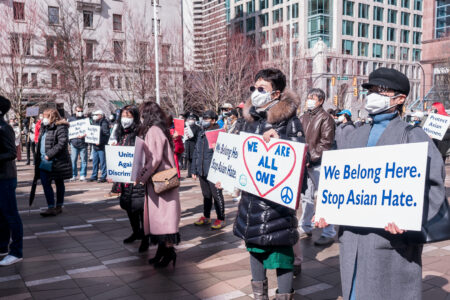
A few weeks ago, a judge of the Ontario Court of Justice found James Sears and Leroy St. Germaine, the editor and publisher of Your Ward News, guilty of willfully promoting hatred against Jews and women (“identifiable groups”), contrary to s. 319(2) of the Criminal Code of Canada. Your Ward News is a free community newspaper that is distributed in the Beaches area of Toronto and is also available online.
Many of the leading hate speech cases in Canada involve anti-Semitic speech. The Sears case, though, is the first in which a court has found an individual guilty of promoting hatred against women. This decision could signal a more general recognition that misogynist speech contributes to both large-scale and individual acts of violence against women.
The Canadian courts have said that the Criminal Code ban on hate speech restricts only a narrow category of “extreme” expression – expression that vilifies the members of a group and is likely to stir up hatred. The judge in the Sears case found that many of the stories and cartoons in Your Ward News met this high standard – noting that the publication described women as traitors, property, sources of corruption, and asserted that rape and other forms of gendered violence is often justified. In reaching this conclusion, the judge referred to recent acts of mass murder, such as the North York van attack, which was motivated by the driver’s hatred of women.
What is hate speech
Despite the public commitment to freedom of expression, legislators and judges have recognized that, when speech is hateful in its content and visceral or irrational in its impact, it carries too many risks, particularly when it circulates within a racist subculture that operates at the margins of public discourse.
At the core of hate speech is a claim that is false – that denies the equal worth or basic dignity of some individuals based on their race, or other identity or association, or, more often, that falsely attributes dangerous or undesirable traits to the members of such a group. When the speaker makes false claims about the members of a group that are so extreme they can be understood as justifying violent action against them, we recognize there is a risk that these claims will influence the audience’s thoughts and actions.
While the tone of the communication – the anger in its message or its appeal to fear – contributes to its impact on the audience, the harm or wrong of hate speech is not that it offends. Indeed, critics of hate speech regulation often describe the wrong in such terms (as offence to the target group’s members) and then proceed to make the point that offence is a subjective matter and as such cannot be the basis for a legal ban on speech. Hate speech, though, is objectionable not because it is offensive (which it is) but rather because it cultivates hateful attitudes and contributes to hateful actions.
Why hate speech is dangerous
Hate speech can create a significant risk of harm when it is directed at a sympathetic audience in a context that limits the opportunity or likelihood of independent judgment – more particularly, when it plays to fears and resentments, builds on existing (mainstream) prejudices, and occurs away from critical scrutiny. While most members of the community will dismiss the extreme claims of hate-mongers as bizarre and irrational, some individuals, already weighed down by prejudice or burdened with fears and resentments, might see in these claims a plausible account of their social and economic disappointments and perhaps also a justification for violent action.
The concern, then, is not, or at least not principally, that hate speech will contribute to the spread of prejudiced attitudes across the general community, leading to more widespread discrimination against minority groups. Instead, the concern is that individuals, or small groups, who are already inclined to bigoted or racist thinking, might be encouraged or emboldened to take extreme action against the target group’s members.
Hate speech law does not extend to the expression of bigoted views that are part of mainstream discourse and contribute to acts of daily discrimination. Any attempt to exclude from public discourse speech that stereotypes or defames the members of an identifiable group would require extraordinary intervention by the state and would dramatically compromise the public commitment to freedom of expression. We need to find other ways to address or confront these less extreme forms of discriminatory expression.
In my view, the primary concern of contemporary hate speech law must instead be to prevent the encouragement of “isolated” acts of violence against members of an “identifiable group.” Hate crimes are committed most often not by organized groups, but by individuals who have immersed themselves in the extremist subculture that operates at the margins of public discourse, and principally on the Internet.
Linking hate speech to violence
Speech that attributes dangerous or undesirable traits to a group that has in the past been the target of a campaign of violence is more likely to be seen as hate speech – as causing, or creating a risk of, significant harm. We are more likely to discern a link between a particular instance of hateful speech and the spread of hatred or the occurrence of violence when there is a recognized pattern or history of hatred and violence against the group. Because phrases such as “the solution to the Jewish problem” or symbols, such as the swastika, evoke the Holocaust, it is easy to attribute a violent purpose to an individual who uses them and to connect the speech to violent action. Yet, in the case of harsh, vitriolic statements made about other identifiable groups that do not have the same recent history of organized violent persecution, it can be harder to discern a violent purpose or effect. Indeed, in the past we have been disinclined to view Islamophobic speech or misogynist speech as a call or prelude to violence against Muslims or women.
Most people in the community who hear misogynist or Islamophobic speech do not act on it in a direct or obvious way. And so when an individual, a so-called lone wolf, such as the man who murdered six worshippers at a Quebec mosque, or the North York van driver who murdered 10 people, commits an extraordinary act of violence, his action is regarded as an isolated act, attributable to his moral deficiency or mental illness, and unconnected to the vicious and hateful material that circulates online and elsewhere, in which both murderers immersed themselves.
The question now is whether these and other general acts of violence against Muslims and women make it more likely that Islamophobic and misogynist writings will be viewed as hate speech – as encouraging the violent oppression of Muslims or women. In the Sears case, the judge referred to these recent acts of mass murder: “The preeminent concern noted a half century ago, that hate propaganda could contribute to violence, is starkly relevant today. The Toronto van attack in April 2018, the Quebec mosque attack in January 2017, and the Pittsburgh synagogue attack a few months ago, are all present day displays of extreme hatred of identifiable groups. The extent to which hate propaganda, such as that which YWN published, bears responsibility in these cases, is still undergoing investigation.”
The judge’s references to the North York van murders and the Quebec mosque shooting indicate that we could be starting to draw a link between hateful speech targeting woman and Muslims and acts of violence, including more individualized acts directed at the members of these groups.
Photo: James Sears and LeRoy St. Germaine (right) leave court after being found guilty of promoting hate in Toronto on Thursday, January 24, 2019. The two men behind a free Toronto area newspaper that promotes legalizing rape and denies the Holocaust were found guilty on Thursday of promoting hatred against women and Jews. THE CANADIAN PRESS/Frank Gunn
Do you have something to say about the article you just read? Be part of the Policy Options discussion, and send in your own submission. Here is a link on how to do it. | Souhaitez-vous réagir à cet article ? Joignez-vous aux débats d’Options politiques et soumettez-nous votre texte en suivant ces directives.









